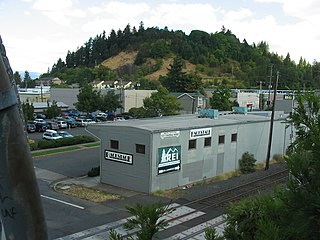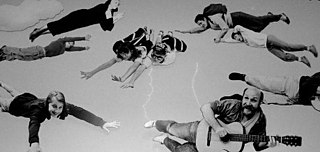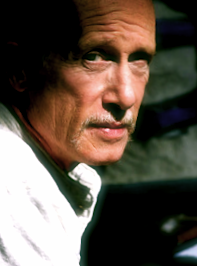
Eugene is a city in the U.S. state of Oregon, in the Pacific Northwest. It is at the southern end of the verdant Willamette Valley, near the confluence of the McKenzie and Willamette rivers, about 50 miles (80 km) east of the Oregon Coast.

Skinner Butte is a prominent hill on the north edge of downtown Eugene, Oregon, near the Willamette River. A local landmark, it honors city founder Eugene Skinner and is the site of the municipal Skinner Butte Park. During the early 1920s, the city's Ku Klux Klan members etched the letters "KKK" into the side of the butte and installed a cross near the top. Local Klan members were said to have burned the cross during meetings. The letters were removed and replaced with the letter "O" in the late 1920s. The cross was replaced several times since the Klan first erected it. However, the cross wasn't permanently removed until 1997.

Eugene Franklin Skinner was an early American settler in Oregon and founder of the city of Eugene, Oregon, which is named after him.
Jerry Ross is an American painter.
Willamalane Park and Recreation District maintains and operates five recreation facilities and 46 parks and natural areas, totaling more than 1,500 acres. Highlights include 10 waterfront areas, 29 miles of hiking and biking trails, 9 sports fields and 27 playgrounds. Willamalane offers hundreds of recreation programs to more than 60,000 patrons. Created by voters in 1944, Willamalane is a special tax district, separate from the city of Springfield, Oregon, with its own boundaries. It is governed by a five-member, elected board of directors and managed by a district superintendent. Willamalane offers:

The 2002 Oregon State Beavers football team represented Oregon State University in the Pacific-10 Conference (Pac-10) during the 2002 NCAA Division I-A football season. Led by fourth-year head coach Dennis Erickson, the Beavers compiled a 8–4 regular season record, but lost the Insight Bowl to the Pittsburgh Panthers in Phoenix on December 26.

The Pioneer is a thirteen-foot-tall bronze sculpture located on the University of Oregon campus in Eugene, Oregon, United States. It was the artistic work of Alexander Phimister Proctor, commissioned by Joseph Nathan Teal, a Portland attorney. A ceremony celebrated its unveiling on May 22, 1919. It included attendance from persons all across the state, the majority of enrolled students, and a special section of the crowd was reserved for the remaining pioneers. Pioneer T. G. Hendricks and his granddaughter removed the canvas cover, unveiling the statue.

The Pioneer Mother is a sculpture located on the University of Oregon campus in Eugene, Oregon. Burt Barker donated the six-foot-tall bronze sculpture, created by artist Alexander Phimister Proctor, to the university. Barker's daughter, Barbara Barker, introduced the sculpture to a public gathering of hundreds on May 7, 1932, during Junior Week and Mother's Day festivities.

Talos No. 2 is an outdoor 1959–1977 bronze sculpture created by the American artist James Lee Hansen. It is located in the Transit Mall of downtown Portland, Oregon, in the United States.

Vera Katz, also known as Mayor, Vera Katz, is an outdoor bronze sculpture depicting Vera Katz created by American artist Bill Bane. Unveiled in 2006, it is located along the Eastbank Esplanade in Portland, Oregon. Katz, a former mayor of the city between 1993 and 2005, supported arts and culture during her tenure and established Oregon's Percent for Art program. She was also instrumental in developing the Eastbank Esplanade, which is named after her. The sculpture has received a mostly positive reception and has inspired people to adorn it with clothing, flowers and makeup.

This All Happened More or Less is a 2014 outdoor public art installation by Crystal Schenk and Shelby Davis, located along Southeast Division Street in Portland, Oregon, United States.

Korean Temple Bell, part of the sound installation by composer Robert Coburn called Bell and Wind Environment, is an outdoor bronze bell by an unknown Korean artist, housed in a brick and granite pagoda outside the Oregon Convention Center in Portland, Oregon, United States.

The Storyteller, also known as the Ken Kesey Memorial, is an outdoor bronze sculpture by Pete Helzer, installed at Kesey Square in Eugene, Oregon, in the United States. Unveiled in 2003, it depicts American novelist, essayist, and countercultural figure Ken Kesey reading to his three grandchildren, Kate Smith, Caleb Kesey and Jordan Smith. Plaques on the base of the sculpture contain excerpts from Kesey's novels One Flew Over the Cuckoo's Nest (1962) and Sometimes a Great Notion (1964).

Flight Patterns, also known informally as Flying People, is a seven-panel photographic sculpture installation of 176 black and white cutouts by David Joyce, designed to be installed in 1989 in Concourse A at the Eugene Airport in the U.S. state of Oregon. During airport construction in 2015–2016, it was moved to Lane Community College. The airport renovations were completed by early January 2017, and all but about 30 of the original Flight Patterns images were reinstalled at the airport in early December 2017.

Indian Maiden and Fawn is a 1917–1924 sculpture by Alexander Phimister Proctor.

Rosa Parks is an outdoor 2009 bronze sculpture depicting the African-American Civil Rights activist of the same name by Pete Helzer, installed outside the bus station in Eugene, Oregon, in the United States.
Betsy Wolfston is an American ceramicist whose works include large public installations and smaller high-relief tiles. She is based in Eugene, Oregon.
Kate Ali is an American visual artist based in Eugene, Oregon. She is a sculptor, teaching artist, and local arts education advocate who creates public works and sculptures. She is also a project manager for the Oregon Arts Commission’s Percent for Art program.

Michael Stuart Leckie is a neo-classical sculptor in Eugene, Oregon.

The Theodore Roosevelt Memorial is a lost monument and sculpture commemorating the 26th president of the United States, Theodore Roosevelt, as well as veterans of the Spanish–American War. It was originally installed in Portland's Battleship Oregon Park. Designed by American artist Oliver L. Barrett, the 18-foot (5.5 m) memorial was erected in 1939, but disappeared in 1942 after being relocated temporarily during the construction of Harbor Drive. It featured a geometric tufa statue depicting a man not resembling Roosevelt, as well as a smaller realistic sculpture of him. The monument initially received a generally unfavorable reception, but was considered one of Barrett's best-known artworks.

















